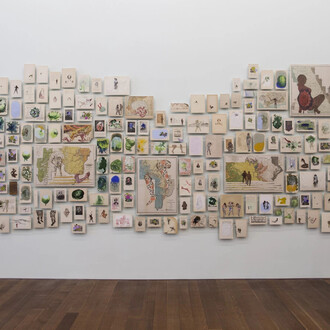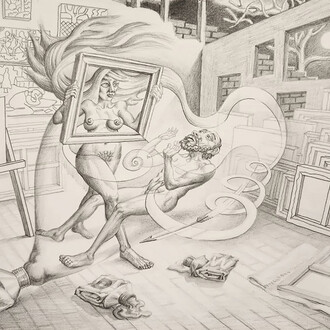The Art Institute of Chicago revisits the social and political turmoil of American cities in the 1960s and ’70s with the exhibition The City Lost and Found: Capturing New York, Chicago, and Los Angeles, 1960–1980, on view Oct. 26, 2014, through Jan. 11, 2015, in the museum’s Modern Wing.
The City Lost and Found is a groundbreaking examination of the changing landscape of American cities during the 1960s and ’70s through the intersection of photography, film, architecture, and urban planning. Breaking from traditional disciplinary boundaries, the exhibition highlights the collective impact of practices from a wide range of makers and thinkers—from documentary photographers, urban planners, architects, and filmmakers to performance artists—focused on the artistic and social potential of urban places. Developed by the Art Institute and the Princeton University Art Museum, the exhibition examines this seminal period of crisis and creativity in America’s three largest cities through more than 150 photographs, films, collages, sculptural works, and ephemera drawn from the collection of the Art Institute as well as from lenders across the country.
The American city of the 1960s and ’70s witnessed seismic physical changes and social transformations, from shifting demographics and political upheaval to the aftermath of decades of urban renewal. This exhibition charts an important shift in photographic and cinematic practice that moved away from aerial views and sweeping panoramas to represent cities through in-depth and close-range studies of streets, neighborhoods, and seminal urban events. In turn, these new images and ideas capturing the specificity and complexity of the urban environment led a new generation of architects, urban planners, and sociologists to challenge long-held attitudes about the future of inner city neighborhoods.
The exhibition features projects by practitioners known for their profound connection to particular cities, such as Romare Bearden in New York, Julius Shulman in Los Angeles, and Art Sinsabaugh in Chicago, while also recontextualizing works by internationally renowned artists, filmmakers, and architects, including Robert Adams, Reyner Banham, Bruce Davidson, Hans Haacke, Allan Kaprow, Helen Levitt, Gordon Matta-Clark, James Nares, Barnett Newman, Martha Rosler, Paul Rudolph, Ed Ruscha, Thomas Struth, Mierle Laderman Ukeles, Wolf Vostell, Garry Winogrand, and Shadrach Woods. Blurring the line between artists, activists and journalists, these works demonstrate connections between art practices and the political, social and geographic realities of American cities in the 1960s and ’70s.
Organized by city, the exhibition explores three major themes that define changing attitudes toward American cities during this period: preservation, demonstration and renewal. The first presents artistic responses to the public call for the preservation of authenticity and community in city neighborhoods, juxtaposing pieces like James Nares’ experimental film Pendulum (1976), which recalls the languid motion of a wrecking ball; architect Shadrach Woods’s unique approach to historic preservation for a new mixed-use district in Lower Manhattan; and photographer Bruce Davidson’s East 100th Street (1966–68), a two-year project exploring poverty and social resilience in the New York neighborhood of Harlem.
The second theme addresses the idea of demonstration in the broadest sense, encompassing political protests in American cities during the 1960s, in works such as Garry Winogrand’s photograph of a New York labor demonstration, and Barnett Newman’s sculpture Lace Curtain for Mayor Daley (1968), created in response to the violence of the Chicago Democratic National Convention. This theme also includes provocative temporary appropriations of streets and urban neighborhoods, such as the mural project West Wall (1968) by photographer Roy Lewis, and Allan Kaprow’s little known Happening Moving (1967), which followed the artist and his collaborators moving among three abandoned apartments in Chicago.
The third theme, renewal, presents new and alternative visions for the future of American cities, such as Arthur Tress’s photographic portfolio Open Space in the Inner City (1971), created as a kind of interactive exhibition of images reflecting the many possibilities for abandoned lots, industrial piers, and other neglected spaces in New York. This ideal is also highlighted in a series of photographs and designs charting the transformation of Bunker Hill in Los Angeles, including Julius Schulman’s seductive, yet uncanny 1968 photograph contrasting new office towers against the last two Victorian houses being removed from this formerly residential neighborhood, and John Humble’s portrait of the new and old downtown in 300 Block of Broadway, Los Angeles, October 3, 1980.
Together, the works in this exhibition present an under-examined context for photography and urban interventions in American cities during the 1960s and 1970s. The City Lost and Found is accompanied by a 272-page catalogue published by the Princeton University Art Museum with essays by the exhibition curators Alison Fisher (Art Institute of Chicago), Katherine Bussard (Princeton University Art Museum), and Greg Foster-Rice (Columbia College, Chicago), as well as contributions from 18 scholars of art history, architecture, film, and urban studies.
Related programs include a symposium co-hosted with the University of Chicago November 20–21, 2014, and as a series of film screenings. Details will be available on the Art Institute website www.artic.edu and in the November-December issue of Member Magazine. The exhibition will travel to the Princeton University Art Museum in spring 2015.
















